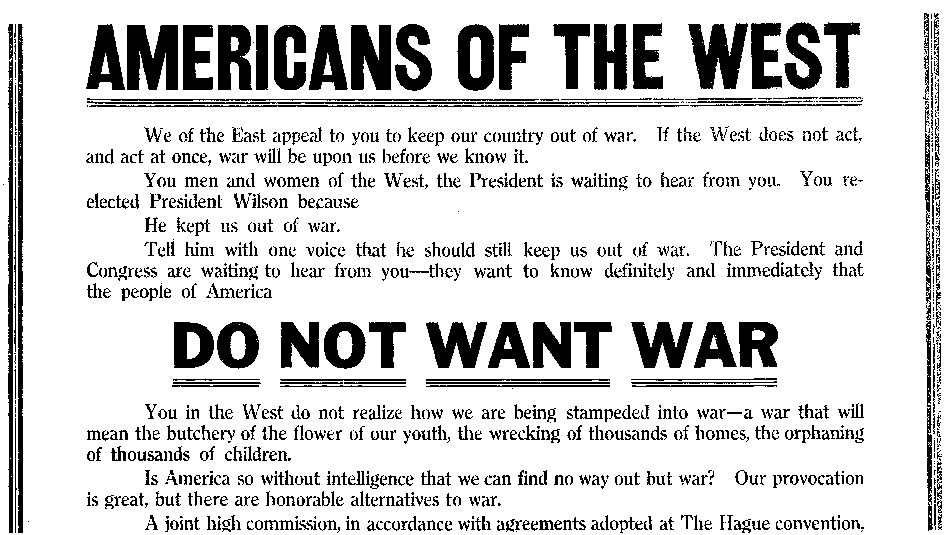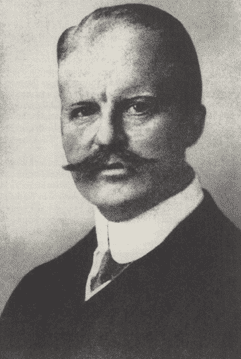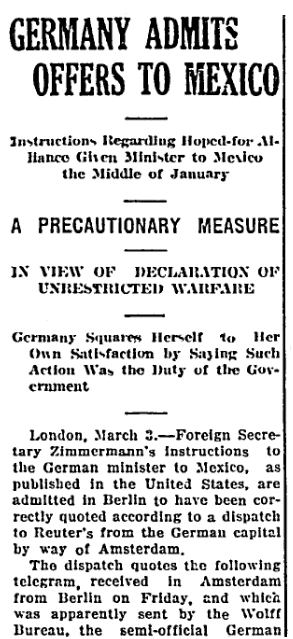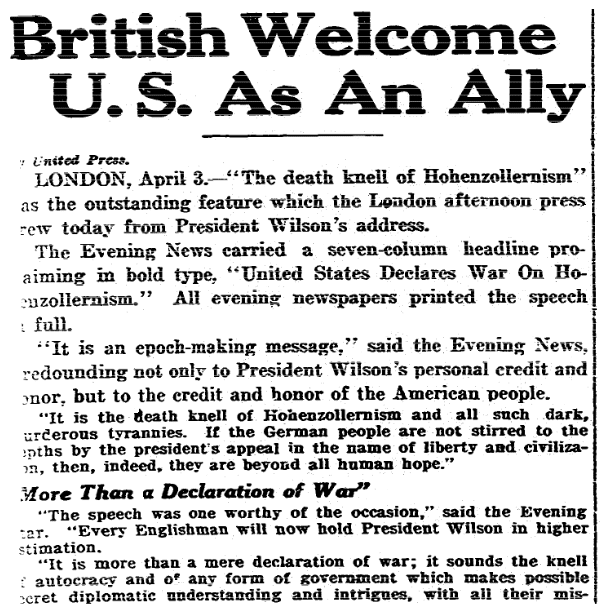Introduction: In this article, Gena Philibert-Ortega searches old newspapers to learn more about the Zimmermann Telegram, an incident that helped push the United States into World War I. Gena is a genealogist and author of the book “From the Family Kitchen.”
The sinking of the British ocean liner Lusitania by the Germans, with the loss of American lives, didn’t do it. The needs of the U.S. allies didn’t do it. What finally did it was a telegram, intercepted and decoded by the British, that broke the proverbial straw on the camel’s back. The Zimmermann Telegram did what no previous action could do: force U.S. President Woodrow Wilson to declare war.

By January 1917, the United States allies had been fighting the Germans for nearly three years. One would assume that our allies were less than thrilled with President Wilson’s decision not to declare war on Germany and the Central Powers. President Wilson was so adamant about not being involved in the Great War that his second-term campaign slogan in 1916 reminded voters that “He kept us out of war!” But like many campaign promises, it would eventually need to be broken.
This 1917 anti-war newspaper advertisement was run by a group called the “Emergency Peace Federation.”

Who Was Zimmermann?
The United States had stayed neutral through the opening years of the Great War. However, in February 1917 Germany broke its Sussex pledge, in which it had promised to not sink merchant ships without warning, and to save human lives if possible. That broken promise signaled the possibility of the sinking of American ships – and it seemed the U.S. could not stay neutral for much longer. It was because of this broken promise that the U.S. broke diplomatic ties with Germany.
Arthur Zimmermann was the State Secretary for Foreign Affairs of the German Empire from 22 November 1916 until his resignation 6 August 1917.

In January 1917 Zimmermann sent a telegram to the German Minister to Mexico suggesting that if the United States did not remain neutral, then Mexico could form an alliance with Germany. The benefit of a Mexican alliance with Germany?
Germany promised Mexico previously lost territory – the Southwestern United States – as a reward for its alliance with Germany.
In part the telegram stated:
We intend to begin on the first of February unrestricted submarine warfare. We shall endeavor in spite of this to keep the United State of America neutral. In the event of this not succeeding, we make Mexico a proposal of alliance on the following basis: make war together, make peace together, generous financial support and an understanding on our part that Mexico is to reconquer the lost territory in Texas, New Mexico, and Arizona.*
England had deciphered this telegram in January 1917 but for various reasons, including not wanting to reveal its intelligence gathering operation, it waited until February 24 to tell President Wilson. It was not too long before U.S. newspapers were informing the American public of Germany’s promise to the U.S.’s southern neighbor.**

The U.S. Declaration of War
Great Britain and her allies most likely breathed a sigh of relief when the U.S. finally declared war. On April 2, President Wilson gave a speech and asked Congress for a declaration of war. Four days later, on 6 April 1917, the U.S. Congress declared war upon the German Empire.
Following the president’s request to Congress, this 3 April 1917 newspaper article explains that “Every Englishman will now hold President Wilson in higher estimation.”

The United States was not at war for too terribly long. June 1917 saw U.S. troops landing in France, and the armistice ending the war was signed over a year later on 11 November 1918. Although the time fighting was shorter for Americans than European countries, it was still a war that resulted in death, dismemberment, and anger that would see another world war in the not-too-distant future.
World War I Timeline***
- 28 June 1914: Archduke Franz Ferdinand assassinated in Sarajevo.
- 28 July 1914: Austria-Hungary declares war on Serbia. World War I begins.
- August 1914: Britain declares war on Germany. France declares war on Austria-Hungary. German conducts air raid on Paris.
- 31 October 1914: Japan attacks and captures Tsingtao, China.
- 25 December 1914: Christmas Truce observed on the Western Front.
- 1 January 1915: Bread rationing introduced in Germany.
- 2 February 1915: German officer arrested in Maine for blowing up Canadian Pacific Railroad Bridge.
- 7 May 1915: German U-boat torpedoes RMS Lusitania.
- 6 October 1915: Serbia is invaded by Germany, Austria, and Bulgaria.
- 12 October 1915: British nurse Edith Cavell is executed by Germany after being accused of being a spy.
- 22 April 1916: Belgians deported to Germany as forced labor.
- 7 November 1916: U.S. President Woodrow Wilson is reelected with the slogan “He kept us out of war!”
- 3 February 1917: U.S. severs diplomatic relations with Germany.
- 1 March 1917: U.S. public learns of the Zimmermann Telegram.
- 1 April 1917: German U-boat sinks the SS Aztec, an American steamer, killing 28 Americans.
- 6 April 1917: U.S. declares war on Germany.
- 25 June 1917: First American troops land in France.
- 20 July 1917: First American draftees are chosen by lottery.
- 21 October 1917: First American combat soldiers killed.
- 7 November 1917: Bolsheviks seize power in Russia.
- 11 March 1918: First report of influenza at Camp Funston (Ft. Riley) Kansas.
- 31 March 1918: U.S. begins Daylight Saving Time.
- 15 July 1918: Bolsheviks murder the Czar of Russia and his family.
- 17 October 1918: Hungary separates from Austria.
- 10 November 1918: Emperor Karl of Austria abdicates.
- 11 November 1918: Germany signs armistices.
- 1 December 1918: Yugoslavia proclaimed an independent state.
- 28 June 1919: Germany and allies sign the peace treaty.
Note: An online collection of newspapers, such as GenealogyBank’s Historical Newspaper Archives, is not only a great way to learn about the lives of your ancestors – the old newspaper articles also help you understand American history and the times your ancestors lived in, and the news they talked about and read in their local papers. Did any of your ancestors serve in World War I? Please share your stories with us in the comments section.
Related Articles:
- The 100th Anniversary of the Sinking of the RMS Lusitania
- WWI Christmas Truce: When the Guns Stopped Firing
- 1918 Surrender of Germany Ends WWI & Veterans Rejoice
* “The Zimmerman Telegram,” National Archives (https://www.archives.gov/education/lessons/zimmermann: accessed 17 March 2017).
** Interested in looking at the Zimmerman telegram? The National Archives article about the telegram includes an image of the actual coded message and the decoded version. You can learn more on their website < https://www.archives.gov/education/lessons/zimmermann.
*** “Interactive WWI Timeline,” National World War I Museum and Memorial (https://www.theworldwar.org/explore/interactive-wwi-timeline: accessed 28 March 2017).
